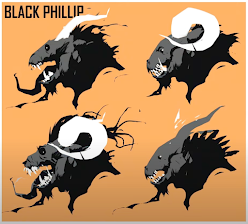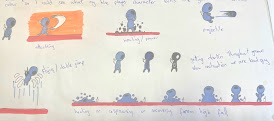So beginning to look at how some of the previously mentioned video games can craft meaningful resonance with an audience with a value placed on something other than entertainment I have tried to pair them up with some sort of commonality in this case it is two studios that take some known cognitive condition and used the research upon such sensitive subject matter to further develop their game and all components it is made of.
Starting with Ether One by White Paper Games, which as their website states is a "small independent studio based in Manchester with a goal to deliver compelling narratives that leave you with lingering thoughts long after you've left our worlds." So immediately we can see the values and motive of the studio align with both this idea of a game being more than just a game (emotive not just entertaining) and the sort of direction I find myself wanting to develop games in with my research. This idea of the narrative of a game having lasting effects on the audience also would create a pathway for any sensitive subject matter to not only be even more sensitive for ethical reasons but allow the player to mull over these ideas like a silent debate or conversation between the creators and consumers.
Their debut game Ether One is a perfect example of seeing this company goal come to fruition, choosing to delve into the subject of dementia particularly the type of dementia that can damage an individual's memory which would ordinarily cause significant emotional attatchemnt to certain objects. The individual can look at something/someone and recognize it/them but there is no emotional feeling leaving them with uncertainty.
This knowledge may have led to the design choice of the player collecting items throughout levels to bring back to the hub area whilst solving puzzles (puzzles being in the game perhaps being another representative game function for some of the feelings one may have suffering from dementia or caring for a sufferer). Having players perform this action replicates what can occur with dementia, discussions on forums dedicated to informing individuals about the condition and its subsequent possible symptoms detail how sufferers may move objects around trying to alter their location to resemble what they perceive and believe to be their actual home or other unique location whilst Michael Thomsen comments on his article about the game for The New Yorker how the hoarding nature of collecting these items in the game reminded him of how he would hoard all sorts of objects to fill his grandmothers room at a nursing home to help her feel at home, not knowing which items would help more due to not fully understanding another individuals own unique interactions with objects and what significant emotional value they may have placed on them or if this value even remained due to the dementia.
Understanding the subjectivity and scaled variety of player exposure to the condition allowed the team to overcome this potential problem when crafting the game based on this theme. Pete Bottomley, the co-founder of White Paper Games, has discussed the positive of working with a small team who all had some experience with "dealing with dementia patients" and how they could evaluate the work in progress quickly by assessing the credibility of its details as opposed to a larger more decompartmentalized company with less overall interactions. However, dementia has several forms with identifiable symptoms, though some crossover is apparent, the length of time the individual has had the condition also changes the severity of the symptoms, therefore, no obvious game mechanic could cover the entire disorder's details whilst simultaneously leaving each player with "lingering thoughts" as Dr. James Galving simplifies with a common expression being "If you've seen one Alzheimers patient you've seen one Alzheimers patient". Being directive with a mission at the start of the game where the player takes control of an individual tasked with recovering another character's memories sets all players on the same task, even if it brings up a variety of different connections from players based on their own experiences with dementia, the separation of player from protagonist allows for this variety. This is also praised by Thomsen who has described the difficulty in video games as a medium to convey subject matters in general compared to film and text before going on to detail how "Playing fast and loose with the laws of physics for Super Mario is forgivable, but systematizing dementia and Alzheimer's runs the risk of alienating audiences by oversimplifying for the sake of drama, or by overstating how much is known about the diseases." This choice also allowed for a narrative three-act structure with the original mission being the exposition of what theme the game was dealing with (Act 1) before an 'inciting incident' in this case being when players realize they are not inside another person's mind but in fact trying to cure their own and confronting this dilemma (Act 2), before finally forming a conclusion to the narrative with a satisfying conclusion that resolves all plots (Act 3). This twist of going from having the player helping a dementia patient to putting them in the shoes of an individual suffering from the disorder completes the studio brand goals by allowing players to craft their own empathy for the theme of dementia through compelling narrative as well as informing players of the condition with a nuanced manner that doesn't alienate players no matter how much previous exposure they may have had to it prior to playing the game.
 |
| Even the graphic style used for production imagery evokes a sense of things fading emulating that of an individual's memories when they have dementia. |
This deliberate separation and then conjoining of a player and sufferer of a condition is something not present within Hellblade: Senua's Sacrifice (H:SS) and perhaps results in less empathetic responses to the condition within the game from players since the player is constantly aware of playing as someone else with a condition and we continue through the story to discover how it occurred (though some may have other reasons for continuing such as an enjoyment of the game design or graphics etc). This difference in narrative structure and gameplay design may have occurred due to the aforementioned departmentalization of a larger studio producing H:SS compared to the 6 person team at White Paper Games, with less communication or agrees upon goals for the purpose of the game and how to effectively achieve them. Though H:SS does combat the sensitive subject matter of psychosis, it is with a narrative derived from just one cause (Senua's father abused her and the traumatic event of him killing her own mother) ignoring any other possibilities, exactly what Thomsen described could happen with systematizing and oversimplifying a condition for the sake of drama.
Even though both games achieved high critical acclaim from reviewers such as Metacritic (Ether one scored an average of 78.5/100, H:SS scored an average of 83/100) it could be inferred that these scores are for separate reasons and not directly correlated to the success of implementing a sensitive subject matter into a game to convey an emotive response from the audience. Looking at what praise they receive in the reviews gives more detailed reasoning to the scores with both being applauded for their choice of subject matters though the H:SS review quickly moves to discuss the voice acting performance and relation to Norse Mythology themes present within the game avoiding any further discussion of the subject matter highlighting how the subject matter of H:SS is not the primary takeaway, and so possibly will not have as much resonance with an individual playing the game compared with Ether One.
Understanding the goal or core principle that I may want within a game is key for the production of the game especially if I want to maintain "lingering thoughts with a player" and can help in the decision process of narrative structure and choices, gameplay, and mechanics to both further enhance and enrich the experience of players in terms of the sensitive subject matters.




















































